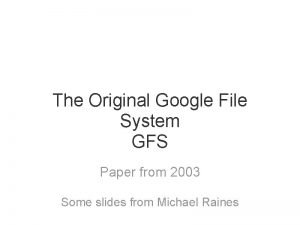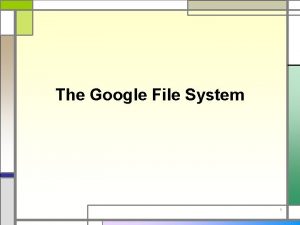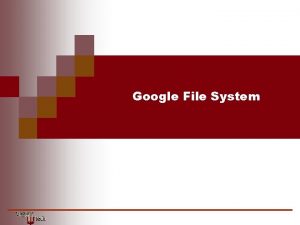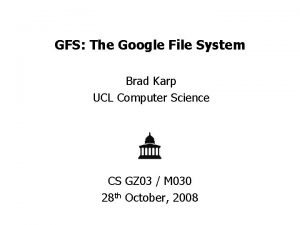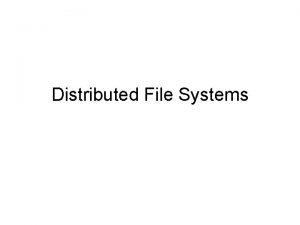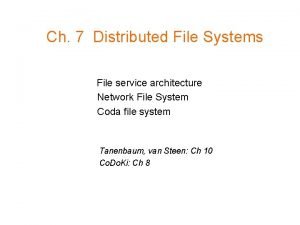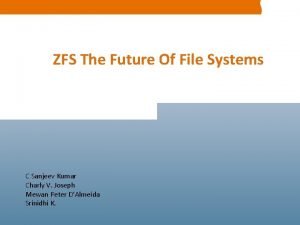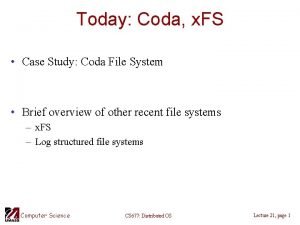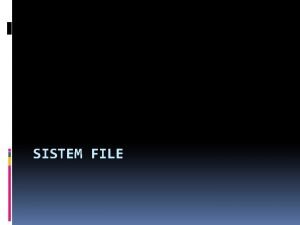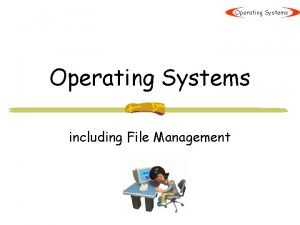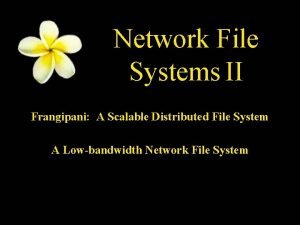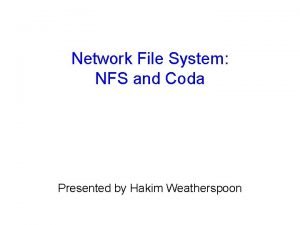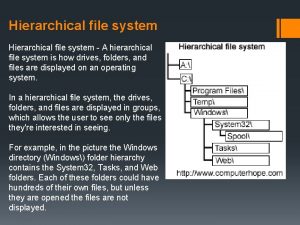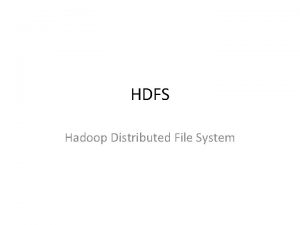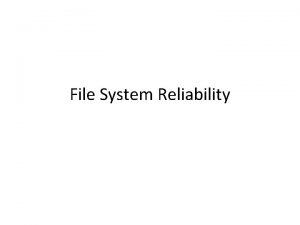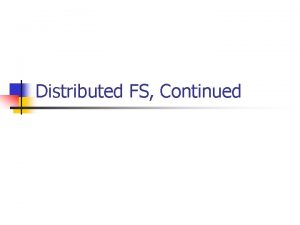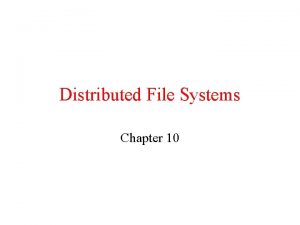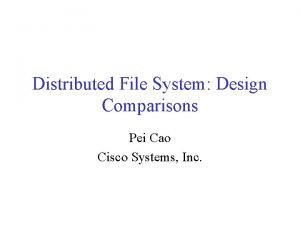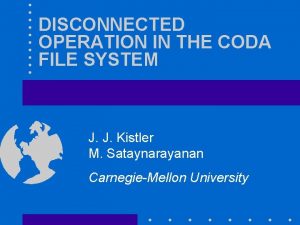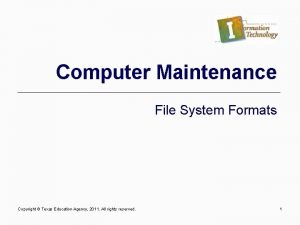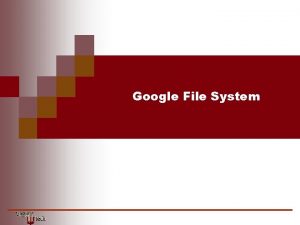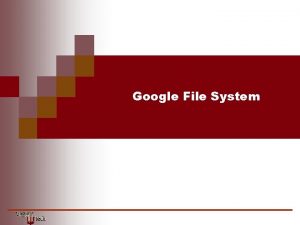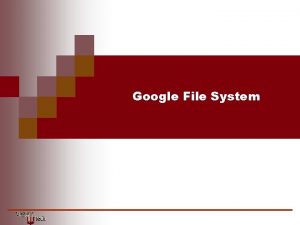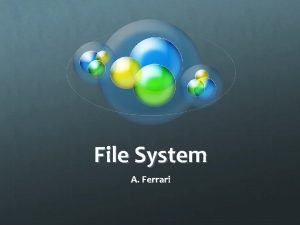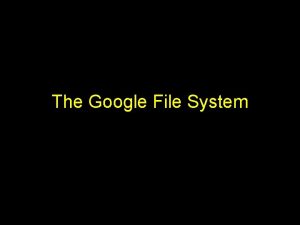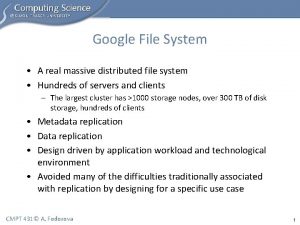Google file System Google file System Google file

















































- Slides: 49

Google file System

Google file System

Google file system (GFS) Google File System, a scalable distributed file system for large distributed data-intensive applications. Google File System (GFS) to meet the rapidly growing demands of Google’s data processing needs. GFS shares many of the same goals as other distributed file systems such as performance, scalability, reliability, and availability. GFS provides a familiar file system interface. Files are organized hierarchically in directories and identified by pathnames. Support the usual operations to create, delete, open, close, read, and write files.

GFS Small as well as multi-GB files are common. Each file typically contains many application objects such as web documents. GFS provides an atomic append operation called record append. In a traditional write, the client specifies the offset at which data is to be written. Concurrent writes to the same region are not serializable. GFS has snapshot and record append operations.

GFS (snapshot and record append) The snapshot operation makes a copy of a file or a directory. Record append allows multiple clients to append data to the same file concurrently while guaranteeing the atomicity of each individual client’s append. It is useful for implementing multi-way merge results. GFS consist of two kinds of reads: large streaming reads and small random reads. In large streaming reads, individual operations typically read hundreds of KBs, more commonly 1 MB or more. A small random read typically reads a few KBs at some arbitrary offset.

Common Goals of GFS and most Distributed File Systems Performance Reliability Scalability Availability

Other GFS Concepts Component failures are the norm rather than the exception. File System consists of hundreds or even thousands of storage machines built from inexpensive commodity parts. Files are Huge. Multi-GB Files are common. Each file typically contains many application objects such as web documents. Append, Append. Most files are mutated by appending new data rather than overwriting

Other GFS Concepts Why assume hardware failure is the norm? It is cheaper to assume common failure on poor hardware and account for it, rather than invest in expensive hardware and still experience occasional failure. The amount of layers in a distributed system (network, disk, memory, physical connections, power, OS, application) mean failure on any could contribute to data corruption.

GFS Assumptions System built from inexpensive commodity components that fail Modest number of files – expect few million and > 100 MB size. Did not optimize for smaller files. 2 kinds of reads – : large streaming read (1 MB) small random reads (batch and sort) High sustained bandwidth chosen over low latency

GFS Interface GFS – familiar file system interface Files organized hierarchically in directories, path names Create, delete, open, close, read, write operations Snapshot and record append (allows multiple clients to append simultaneously - atomic)

GFS Architecture

GFS Architecture

GFS Architecture

Chunk


GFS Architecture A GFS cluster consists of a single master and multiple chunkservers and is accessed by multiple clients, Each of these is typically a commodity Linux machine. It is easy to run both a chunk-server and a client on the same machine. As long as machine resources permit, it is possible to run flaky application code is acceptable.

GFS Architecture Files are divided into fixed-size chunks. Each chunk is identified by an immutable and globally unique 64 bit chunk assigned by the master at the time of chunk creation. Chunk-servers store chunks on local disks as Linux files, each chunk is replicated on multiple chunk-servers. The master maintains all file system metadata. This includes the namespace, access control















GFS is fault tolerance?



Consistency

Consistency


Write control and data flow

Replica placement

Replica placement

Garbage Collection








 File-file yang dibuat oleh user pada jenis file di linux
File-file yang dibuat oleh user pada jenis file di linux Gmailgmailgmailgmail
Gmailgmailgmailgmail Remote file access in distributed file system
Remote file access in distributed file system In a file-oriented information system, a transaction file
In a file-oriented information system, a transaction file Google gfs paper
Google gfs paper Google file system
Google file system Gfs architecture
Gfs architecture Googledisk
Googledisk Gfs architecture
Gfs architecture Google file system paper
Google file system paper Sanjay ghemawat
Sanjay ghemawat Physical image vs logical image
Physical image vs logical image Fungsi sistem file
Fungsi sistem file What does a markup tag tells the web browser
What does a markup tag tells the web browser File system modules in distributed system
File system modules in distributed system Sun nfs architecture
Sun nfs architecture File system in operating system
File system in operating system Ufs4.0
Ufs4.0 File system in operating system
File system in operating system Google search by file type
Google search by file type Https drive google com file d 1zphjwy1qqf1g
Https drive google com file d 1zphjwy1qqf1g Google backup and sync vs file stream
Google backup and sync vs file stream Add calendar to google forms
Add calendar to google forms Konichiwa prijevod
Konichiwa prijevod Google acadêmico (https //scholar.google.com.br/)
Google acadêmico (https //scholar.google.com.br/) Google docshttps://mail.google.com/mail/u/0/#inbox
Google docshttps://mail.google.com/mail/u/0/#inbox Zfs distributed file system
Zfs distributed file system Namei algorithm in unix
Namei algorithm in unix Coda file system
Coda file system Metode akses file
Metode akses file Os file management
Os file management Sun nfs
Sun nfs Frangipani: a scalable distributed file system
Frangipani: a scalable distributed file system Coda file system
Coda file system Manipulasi file adalah
Manipulasi file adalah Irt 5433
Irt 5433 Aka.ms/k8slearning
Aka.ms/k8slearning Hierarchical file system
Hierarchical file system Hadoop distributed file system
Hadoop distributed file system File system reliability
File system reliability What is file based system
What is file based system Fast file system
Fast file system Union file system
Union file system E office file management system
E office file management system Replicated file system
Replicated file system Coda file system architecture
Coda file system architecture Distributed file system comparison
Distributed file system comparison Coda file
Coda file File system
File system Fat file system
Fat file system




